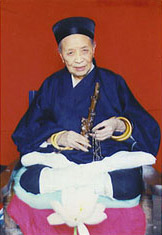
Lao Tzu
The tradition of Dao (Path or Way) was formulated by Lao Tzu in approximately 500 BC.Lao Tzu built on the existing Chinese teachings stemming from the Yellow Emperor, Huangdi, 黃帝 (2698–2598 BC), which were almost certainly influenced by the esoteric teachings spreading out from Mesopotamia over the preceeding 500 years.
Daoism, Confucianism, Buddhism
Daoism was externalised by Confucius around the time of Lao Tzu and spread throughout Asia with the migration of the Chinese people.Around the 5th Century AD – according to some records but possibly much earlier – 1000 years after the Buddha's life in Nepal and India, the Buddhist teaching permeated China merging with the inner teaching of Dao and initiating Chan (Zen).
As a way of seeking balance and for practical expression of internal principles, teachers from the Daoist (including Chan) tradition often include training in the martial arts, typically Taiji Quan.
Inner Teachings of Dao by Chang Po-tuan Inner Teachings of Dao by Chang Po-tuan (中文) GoldPassJadeLockMethod(金關玉鎖訣)
Naturalness
is perhaps the most highly valued concept within the Daoist teaching, with Mother Earth as the model. This naturalness refers not to some external ease or lack of effort, but to perfect inner attunement to the Deep Inner Essence of ourselves and consequently the Deep Inner Essence of the wider world.The main method is to gather and refine energy (Qi or Chi). Externally it is practised through physical movements and breathing exercises. Internally it is practised by concentration of the Deep Mind on and within the body and energy field.
The result of perfect inner attunement is spoken of as 'Immortality', where the crystalised energy body reaches that stage of development which will independently support the Deep Mind freeing it from the physical body and its energy supply (both during life and after death).
Balance
is also highly valued, as an aspect of naturalness. The concept of Yin and Yang and the harmonising immaterial Qi depicts balance.The theory of the 5 elements describes the cycles that occur within this balanced system and the distortions that appear when balance is disturbed.